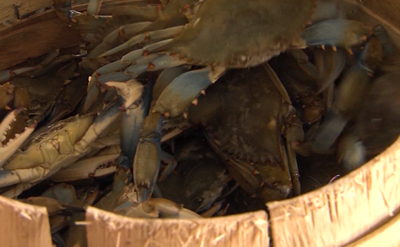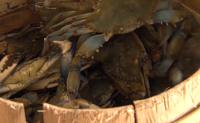MARYLAND - Maryland’s Department of Natural Resources (DNR) has released the results of this year’s winter dredge survey aimed at monitoring blue crab populations in the Chesapeake Bay.
The results, published at noon Wednesday, show a slight decrease in the number of crabs compared to last year, but a stable population overall. DNR says though the number of spawning-age females was slightly down, this population indicator is still well above the management threshold. Adult male crabs also saw a slight decrease, according to DNR.
DNR says the number of juvenile crabs showed a promising increase in 2024, and the population as a whole remains healthy. Total crab abundance showed little change from last year, according to the report.
“An increase in juvenile recruitment is certainly welcome news, and the stock and population as a whole remains healthy,” said Maryland DNR Fishing and Boating Services Director Lynn Fegley. “However the continued relatively low recruitment numbers warrant a closer look at our approach moving forward.”
In total, DNR estimates a population of 317 million blue crabs in the Chesapeake Bay compared to 323 million last year.
The full report, released May 22nd, can be found here.
As far as reaction to this survey release, DNR officials report that the population numbers for Maryland blue crabs are healthy and stable.
"We're doing a decent job controlling the amount of harvest that's occurring," said Mike Luisi, Associate Director of Maryland Fishing and Boating Services with the DNR. Consequently, he says significant changes to crabbing regulations are not expected
"For regulation purposes, we feel pretty comfortable with the way things are. So we're likely not going to change very much. We're taking the approach of more of a status quo from last year," Luisi added.
However, concerns remain regarding juvenile crabs and regulations. Jack Brooks, owner of J.M. Clayton Co., emphasized the importance of juvenile crab survival and the impact of restrictions on the hard crab harvest.
"The survival of those juvenile crabs in the immediate term and the restrictions they place on the hard crab harvest are my concerns," said Brooks.
Despite the increase in juvenile crab numbers, the Chesapeake Bay Foundation (CBF) maintains they are still below average. The CBF attributes this to limited bay grasses, which provide hiding places for crabs, and predatory fish like the blue catfish.
"We likely need to continue to be cautious to protect those adult female crabs to ensure we have the best possible chance of producing more juveniles next year and reversing this downward trend of low juvenile abundance," said Allison Colden, CBF Maryland Executive Director.
The DNR plans to release blue crab regulations by July 1, which will be in effect until June 30 of the following year.



